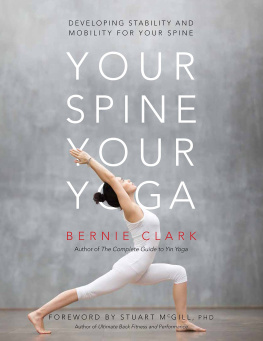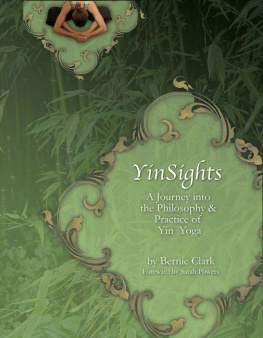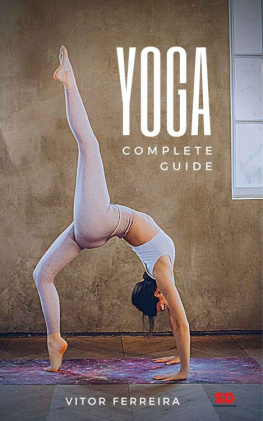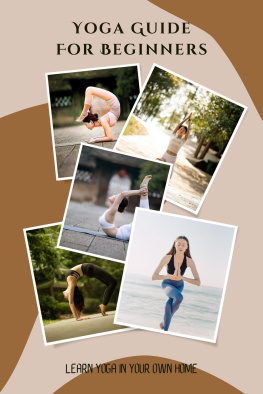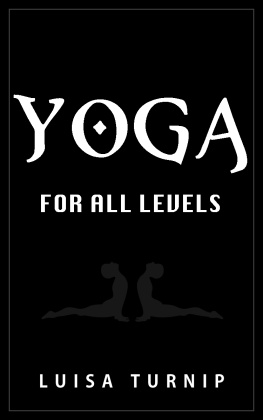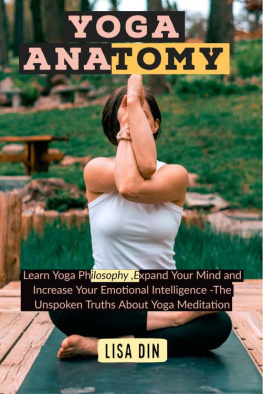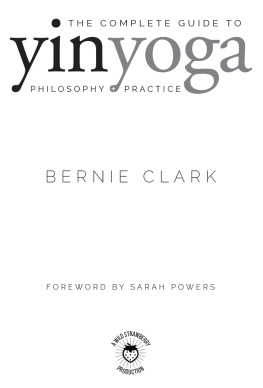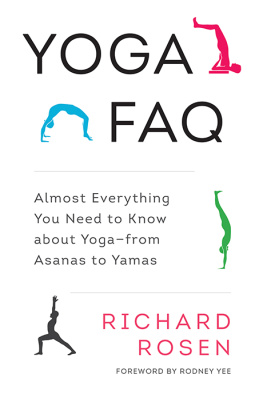THE COMPLETE GUIDE TO
YIN YOGA
THE COMPLETE GUIDE TO
YIN YOGA
The Philosophy and Practice of Yin Yoga
BERNIE CLARK
FOREWORD BY SARAH POWERS
WHITE CLOUD PRESS
ASHLAND, OREGON
All rights reserved. Copyright 2012 by Bernie Clark. No part of this book may be reproduced or transmitted in any form or by any means whatsoever, including graphic, electronic, or mechanical, including photocopying, recording, taping, or by any information storage or retrieval system, without permission from the publisher. Inquiries should be addressed to: White Cloud Press, PO Box 3400, Ashland, OR 97520. Website: whitecloudpress.com
Cover and interior design by Confluence Book Services
Library of Congress Cataloging-in-Publication Data
Clark, Bernie, 1953-
The complete guide to yin yoga : the philosophy and practice of yin yoga / by Bernie Clark.
p. cm.
Includes bibliographical references and index.
ISBN 978-1-935952-37-4
1. Yin yoga. I. Title.
RA781.73.C53 2011
613.7'046--dc23
2011028908
Credits for Art and Photography
Chapters 2, 3, & 4: Photographs of Cherise Richards, our Yin Yoga model, are by Christy Collins. Copyrighted 2011 by Bernie Clark.
Chapter 6: p. 195: The Myofascial-Tendon Complex, reprinted, by permission, from SEER Training Modules, Structure of Skeletal Muscle. U. S. National Institutes of Health, National Cancer Institute. ; p. 196: Collagen Fibers, reprinted, by permission, Matthew P. Dalene and the Rensselaer Plytechnic Institute; p. 201: Connective Tissues, reprinted from Grays Anatomy, 38th Edition, The Anatomical Basis of Medicine and Surgery Copyright, p. 76, by Pearson Professional Limited 1995 and with their kind permission; p. 208: Types of Synovial Joints, reprinted, by permission, Produnis of the Wikimedia Share Commons.
Chapter 7: p. 256: The Cells Cytoskeleton from Energy MedicineThe Scientific Basis, p. 46, copyright Elsevier Limited, 2000, reprinted, by permission, from Elsevier and James Oschman.
For Nathalie, who has come to
share in my belief that yin is truly in!
Table of Contents
T he practice of yoga has always been evolving, but essentially yoga is the cultivation of attention. What we attend to and the attitude with which we attend greatly influence how we experience ourselves and our life. In yoga we concentrate on both form (our bodies and tissues), and formlessness (our breath, energy channels, and mind states). These interconnected aspects of reality are in constant interplay, they are the Yin and Yang of life, and, in yoga we develop and balance these polar complementarities within our body/mind experience. For most of us, beginning with that which is most tangible, the body (Yang) is a common doorway into the practice. As we become less distracted and healthier physically, most students eventually become interested in that which is more hidden. This can be called the yin aspect of reality, which relates with that which is subtle. It is only by paying attention in a relaxed and attuned way that this yin aspect of yoga is revealed.
When students first begin a yoga practice, perhaps to reduce stress or to get in shape, or maybe just to accompany a friend, they will often be guided to place the largest percentage of their attention on the shape of the poses they are trying to do. This keeps the practice safe and as we learn postural integration, our body-based experience becomes more joyous, healthy, and the postures more fun to inhabit. Eventually, with skillful guidance, sincere practitioners become interested not only in the outer forms of yoga, but in the inner revolution that yoga can offer, or, as Bernie might say, they start to go yin-side. It is here that the deeper aspects of yoga are revealed.
Paying attention to the fluctuations of the breath, noticing the sensations ebbing and flowing in the physical body, tracking the changing feelings in the emotional body, and recognizing the space of the mind as well as the thoughts in the mental body are all part of yoga. This yoking or joining of the body, heart, and mind provides health benefits beyond simply being more flexible or stronger. The word health is derived from an Old English word meaning whole. Yoga re-establishes our natural wholeness the balanced integrity of our yin and yang nature.
Adding a yin or quieter aspect to our yoga practice can introduce us to the possibility of physical/emotional/mental equilibrium by marrying the softer, contemplative modes of being in life to the stronger activities we are so often compelled by. This helps reduce the compulsive extremes of behavior that cause us to lose balance, lose focus, and diminish our joy of living. Yang energy is needed to bring vitality to our yin interior, but it is the gentler yin qualities within us that balance our yang intensities. If you have felt that life is too often not how you would like it to be, then learning the ancient art of deep listening, tuning in to the internal, non-conceptual, softer aspects of your yin nature may be the healing direction.
Yin Yoga, when taught skillfully, can provide this opportunity to go within and re-align our orientation. It will also affect our physical body in ways that may surprise us. It is simple, but often challenging. It will provide us with ample periods of stillness within which we can start to pay attention to what is really happening, right here, right now. It can provoke insights that may move us to make significant changes in our life or allow us to accept that what is happening right now is exactly what ought to be happening right now. We may discover ourselves opening up to and connecting with our experience as it is, rather than holding on to resistance and feelings of victimization.
For anyone seeking to learn and benefit from the practice of yoga, this book will be an invaluable guide. Bernie has been a student and friend of mine for many years. I know him to be a thoughtful and dedicated teacher who has helped many through his workshops, website, and writings. Through this book, he is sharing his own practice for all our benefits, seeking to help anyone who desires genuine health and wholeness. Within these pages, you will find explorations on the physical benefits of Yin Yoga and explanations on the ways Yin Yoga helps us energetically as well as emotionally and mentally. The practice of Yin Yoga is described in detail and the various asanas are reviewed in a simple way, allowing them to be fully experienced. For those interested, the evolution of yoga in general and Yin Yoga specifically is also presented.
It is with heartfelt encouragement that I invite you to experience opening within through the study and practice of Yin Yoga.
Sarah Powers
New York
September 2011
M any readers of my previous book, YinSights: A Journey into the Philosophy & Practice of Yin Yoga, wrote to tell me how much they enjoyed reading it and how valuable they found the practice of Yin Yoga. Along with many emails, there were also requests posted in the YinYoga.com Forum asking for even more information: how to get into the poses described in the book and how to safely come out of them, how to do Yin Yoga for the upper body, whether Yin Yoga would be helpful for unique, special situations, and lots of other questions. Many readers asked about the Daoist history that also informed and influenced the development of Yin Yoga. The demand grew for a second edition of YinSights that would cover these and other details of the practice of Yin Yoga.
Unfortunately, a technical challenge arose: adding to the information already presented in YinSights would make the book unwieldy. YinSights was already over 400 pages long and extending it to answer all the questions being raised would make the book too bulky. A second edition did not seem like a good idea. Fortunately the opportunity arose to solve this problem by creating, not a second edition of
Next page

